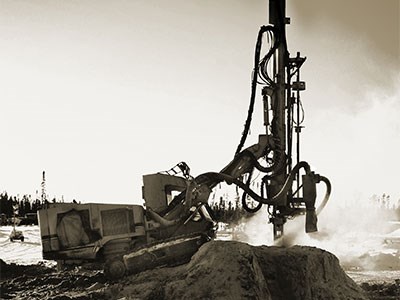Interested in buying a Ring of Fire bond?
The Ontario Chamber of Commerce suggests that could be one way to expedite the lagging development of the series of high-grade chromite and base metals in the James Bay lowlands.
The chamber has released a comprehensive 36-page report – Beneath the Surface – that said the economic benefits to Ontario across all sectors could generate up to $9.4 billion in economic activity over 10 years and sustain 5,500 jobs annually.
“Ontario’s economy is at a historic crossroads,” wrote Alan O’Dette, president and CEO of the Ontario Chamber, who called the Ring of Fire one of this province’s “greatest economic development opportunities in a generation.”
But the “glacial pace” at which progress is being made, he said, makes it seem that its development is “no closer than it was several years ago.”
The OCC said there remain key challenges ahead in dealing with the lack of infrastructure to reach these stranded mineral deposits: a shortage of skilled labour, the need to finalize agreements with First Nations, and in finding ways to reduce the impact of mining in one of the world’s largest wetlands.
After meeting with 150 mining-related stakeholders, the chamber has come up with a 13-step action plan that addresses all those issues.
Much of the research and interviews were led by Liam McGuinty, the chamber’s senior policy analyst, and the son of the former Ontario premier.
A big reason why this report was written is that many southern Ontarians remain clueless when it comes to realizing the Ring’s potential, according to a Leger Marketing survey. And this lack of awareness, the chamber said, has slowed the future mining camp’s development.
The chamber said the Ring’s economic spinoffs will be felt across Ontario; in Thunder Bay’s construction sector, with mining suppliers from Sudbury to Burlington, financial institutions in Toronto, and manufacturers in London.
The chamber’s own number-crunching forecasts that the Ring of Fire could generate $6.2 million for Ontario’s mining industry and deliver nearly $2 billion to federal, provincial and municipal government coffers over a decade.
But the lack of a plan to build and finance the necessary transportation infrastructure to reach the deposits overland has been a major hindrance.
No consensus has been reached on how to do it or pay for it, but the chamber said Ontario has taken a “promising first step” with its Ring of Fire development corporation that’s now being managed by Deloitte Canada.
The report said Ontario must come up with a long-term infrastructure plan for the Far North and both Queen’s Park and Ottawa must pony up the money to fund transportation infrastructure similar to the construction of the St. Lawrence Seaway.
The chamber added the Ring of Fire corporation needs to be given all the tools to deliver on its mandate with representation on its board from key sector players and must be given the ability to issue Ring of Fire bonds to raise money at low interest rates to raise the $2 billion needed to build the needed infrastructure.
To possibly fast-track development before roads or a railroad can be put in, the chamber suggests using hovercraft to transport material to the mine sites and nearby communities.
To spur value-added manufacturing, especially with Ontario’s power prices on the upswing, the chamber wants to see a cost-benefit analysis to deliver a “special electricity incentive” in order to place more mineral processing plants in Ontario.
The chamber said Ontario needs to capture as much of the value-added processes as possible.
Nothing was mentioned in the report about whether Ontario should build a stainless steel manufacturing plant, of which chromite is a key ingredient.
To deal with skilled labour shortfalls, the chamber is calling on employers and post-secondary institutions to build a home-grown workforce by expanding Aboriginal training programs and getting the feds to deliver on a new framework for First Nations education.
The chamber said agreements with Aboriginal communities must be followed through and proper consultation with First Nations must be done. The mining industry especially wants clarity on how to enter into impact benefit agreements and partnerships with First Nations.
Some progress is being made in negotiations involving Ontario and the Matawa Tribal Council, representing the Aboriginal Ring of Fire communities, but the chamber said these agreements must address infrastructure needs, training for meaningful jobs and long-term environmental impacts.
No mention was made in the report of resource revenue sharing with impacted First Nation communities.
On the environmental front, the chamber said Ontario’s regulatory regime inhibits investment and development, and an extensive review must be done to remove barriers that impede mining.
Because the Ring of Fire is located in a largest wetland, the development “should be viewed as an anchor project that can spur innovation.”
Above all, the chamber said, Ottawa needs to declare the Ring of Fire a “national priority” and take a more active role in its development and match the province dollar for dollar.
While the politicians may be sparring, in actuality the chamber said there’s been a “high level of cooperation” between the federal and provincial governments.
After the report is officially released tonight at the Royal Ontario Museum in Toronto, a series of panel discussions will take place next week across Northern Ontario in Thunder Bay (Feb. 26), Sudbury (Feb. 27) and Timmins (March 7).
The Sudbury panel will be held at Dynamic Earth from 4 p.m. to 7 p.m.
Sitting on the Sudbury panel will be Bill Boor, president of Cliffs Natural Resources ferroalloys division, Noront Resources chairman and director Paul Parisotto, Hans Matthews, president of the Canadian Aboriginal Minerals Association, and George Darling, a director with SNC Lavalin in Sudbury.
Doug Morrison, president and CEO of the Centre for Excellence in Mining Innovation (CEMI) in Sudbury will act, as moderator.




